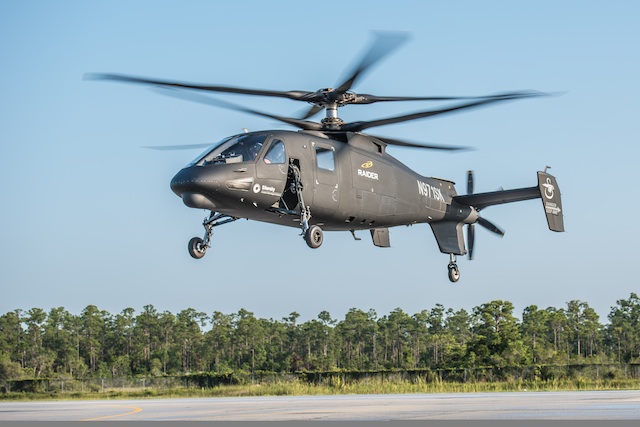Sikorsky has completed a first flight of the self-funded S-97 Raider at the company's flight test facility in West Palm Beach, Florida, to open a year-long test and demonstration phase for the high-speed, compound helicopter proposed for light attack, scout and special utility missions.
The S-97’s coaxial-compound, rigid-rotor configuration will eventually be tested at speeds up to 220kt – or about 50kt faster than the speed limit of most conventional helicopters – but the maiden flight on 22 May focused on exploring the low-speed envelope in a degraded mode of the fly-by-wire system.
Sikorsky chief pilot Bill Fell and co-pilot Kevin Bredenbeck completed three take-offs and landings during the hour-long sortie and evaluated the aircraft’s handling in all four cardinal directions at speeds up to 10kt.
“It was quite the aggressive first flight for a helicopter,” says Bredenbeck, who piloted the X2, the S-97’s proof-of-concept demonstrator.

Sikorsky
Sikorsky launched the S-97 project in 2010 after completing a series of record-breaking demonstration flights of the X2.
A 48-month technology demonstration programme was extended by more than four months to complete several new technologies. The S-97 is configured as a testbed for a variety of development projects within Sikorsky, including components made through additive manufacturing, a low-fastener-count approach to structural assembly, and new composite materials.
“The S-97 is a testbed for a lot new technology and some of those took a little bit longer,” says Sikorsky vice-president of research and engineering Mark Miller.
The S-97 flies faster than most helicopters because it replaces a tail-rotor with a pusher propeller, which was left deactivated for the first flight test. The counter-torque function of the tail rotor is replaced with a counter-rotating, coaxial rotor system that provides vertical thrust for takeoff and landing.
The rigid blades of the coaxial rotor system provide another benefit over a conventional Sikorsky helicopter.
“You have a phenomenal amount of control power with this very rigid rotor,” Fell says. “There is no lag. The aircraft responds immediately to your control input.”
The 5t-class S-97 is part of a wave of industry investment in high-speed technology.
The Bell Boeing V-22 Osprey now flies faster than 260kt and land vertically using a tiltrotor configuration. Bell Helicopter is currently developing the V-280 Valor tiltrotor demonstrator with Lockheed Martin.
The V-280 is competing against a Sikorsky-Boeing compound helicopter design based on same X2 technology as the S-97 with the 13.5t-class SB-1 Defiant.
The V-280 and SB-1 will perform a series of flight tests to validate the high-speed technology under the army’s joint multi-role technology demonstrator (JMR-TD) programme.
Both aircraft designs are expected to compete for a follow-on acquisition programme called Future Vertical Lift, which initially aims to replace the army’s Sikorsky UH-60 Black Hawk and Boeing AH-64 Apache fleets with a single, high-speed rotorcraft.
Source: FlightGlobal.com






















